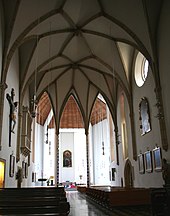Leonhard Church (Graz)
The Roman Catholic Leonhard Church is the parish church of Graz-St. Leonhard of the 2nd district of St. Leonhard in the Austrian city of Graz . It is a late Gothic building with a baroque facade and a recent extension to the east.
Building history
A Romanesque predecessor of today's church was mentioned for the first time in 1361 as S. Lienhart . The church patron Saint Leonhard was probably chosen because he is, among other things, the patron saint of cattle and especially horses, and an important trade route, the Strata hungarica , which used to be used by horse-drawn vehicles, has always passed the Leonhard Church .
In 1433 the original building was replaced by a new building, still largely preserved today, in the tradition of the Leech Church in Graz , and consecrated by the Archbishop of Salzburg. This Leonhard chapel was consecrated as a double patronage to both St. Leonhard and Maria until Leonhard became the only patron of the church in the 18th century. After the Turkish invasions in 1480 and 1532, the church was consecrated again in 1535.
From 1617 to 1620 the church tower was raised and provided with a pointed spire, which was replaced when it was raised again in 1746 and 1747 by the onion spire made by Johann Georg Stengg , which has been preserved to this day . In 1712 a baroque Lady Chapel was built on an elliptical floor plan in the southern part of the church. The west facade and the portal of the church date from around 1775, the portal with the crowning sandstone figures (Saint Leonhard and prisoners - Leonhard is also the patron saint of prisoners) are attributed to Veit Königer . Until 1818, an ancient Roman grave stele from the time of Emperor Trajan was embedded in the outer wall of the church , which is called the Cantius stele after L. Cantius Secundus mentioned in the inscription . It is now in the lapidarium of the Eggenberg Castle Archaeological Museum .
In the 19th century there was a regotization of the church. The high altar (1886), two side altars (1891) and a pulpit (1902) were made from a new design by August Ortwein . As early as 1880, consideration was given to expanding the church to the east by adding an annex, but this was no longer necessary after the nearby Sacred Heart Church was built. In the years 1959 to 1962, on the initiative of Pastor Leopold Haas and based on plans by Karl Lebwohl, a modern extension was added to the east of the church, although the Gothic vaults in the choir were largely preserved. The neo-Gothic high altar was removed.
With a new interior renovation in 1995 under Pastor Franz Fink and architect Manfred Fuchsbichler, the two-part church interior could be designed even more harmoniously and is now inviting both for the celebrating community and for those who pray in silence.
environment
The Leonhardkirche is located on the busy Elisabethstraße or Gleisdorfer Straße B65. The LKH Graz is on the other side of the street . Next to the Leonhardkirche, in Leonhardstrasse, there is the rectory, the Seydler house and the parish center, which was built in 1990, and then the Odilien Institute for the Blind, which was built in its present form at the end of the 19th century.
In the south and east of the church there is the St. Leonhard cemetery with many important grave monuments. Among the people buried here are Julius von Haynau , Wilhelm von Tegetthoff , Ludwig von Benedek , Robert Hamerling , Maximilian von Rodakowski , Richard von Krafft-Ebing and Gustinus Ambrosi . The mausoleum for Anton Graf Prokesch-Osten is noteworthy , a dome-crowned building in oriental shapes designed by Theophil Hansen , the architect of the Austrian parliament building.
literature
- Horst Schweigert : Graz (= The art monuments of Austria . = Dehio -Handbuch Graz. = Dehio Graz. ). Revision. Schroll, Vienna 1979, ISBN 3-7031-0475-9 , pp. 114–116.
- Horst Schweigert: St. Leonhard Graz (= Christian art places of Austria. Vol. 359, ZDB -ID 2182605-5 ). Publishing house St. Peter, Salzburg 2000.
- Alois Kölbl, Wiltraud Resch: Paths to God. The churches and synagogue of Graz. 2nd, expanded and supplemented edition. Styria, Graz 2004, ISBN 3-222-13105-8
Web links
- Homepage of the parish Leonhard with detailed information about the church and cemetery
Coordinates: 47 ° 4 ′ 43 " N , 15 ° 27 ′ 54.6" E




